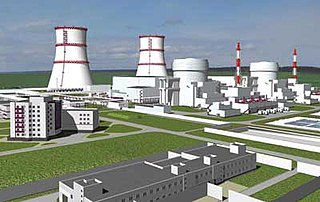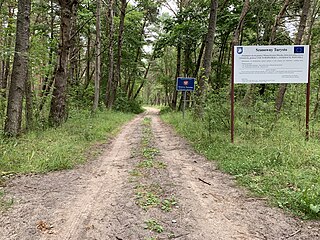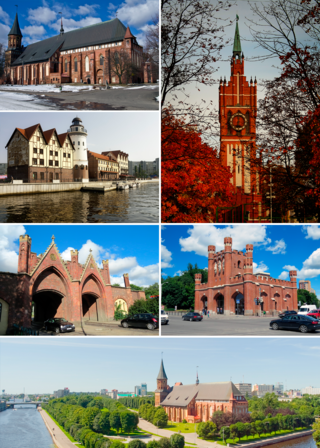
Kaliningrad Oblast is the westernmost federal subject of the Russian Federation. It is a semi-exclave situated on the Baltic Sea. The oblast is surrounded by two European Union and NATO members: Poland to the south and Lithuania to the north and east. The largest city and administrative centre of the province (oblast) is the city of Kaliningrad, formerly known as Königsberg. The port city of Baltiysk is Russia's only port on the Baltic Sea that remains ice-free in winter. Kaliningrad Oblast had a population of roughly 1 million in the Russian Census of 2021.

Sambia or Samland or Kaliningrad Peninsula is a peninsula in the Kaliningrad Oblast of Russia, on the southeastern shore of the Baltic Sea. The peninsula is bounded by the Curonian Lagoon to the north-east, the Vistula Lagoon in the southwest, the Pregolya River in the south, and the Deyma River in the east. As Sambia is surrounded on all sides by water, it is technically an island. Historically it formed an important part of the historic region of Prussia.

Gusev is a town and the administrative center of Gusevsky District of Kaliningrad Oblast, Russia, located at the confluence of the Pissa and Krasnaya Rivers, near the border with Poland and Lithuania, east of Chernyakhovsk. Population: 28,177 (2021 Census); 28,260 (2010 Census); 28,467 (2002 Census); 27,031 (1989 Census).

Russia is divided into twelve economic regions —groups of federal subjects sharing the following characteristics:

European route E28 is a west-east intermediate road in the international E-road network. Beginning at the Bundesautobahn 10 in Germany, it runs west-east for a length of 1,230 km (760 mi) to Minsk, Belarus. The section between Kaliningrad and Minsk is part of the Pan-European Corridor IX.

The flag of the exclave of Kaliningrad Oblast is a rectangle with a ratio of 2:3 divided into three horizontal stripes. The upper stripe is red, a thin yellow stripe in the middle and a dark blue stripe of the same size as the red bar. In the canton is a silver-and-black stylized medieval castle with open gates and the monogram of Empress Elizabeth Petrovna.
Kaliningradsky (masculine), Kaliningradskaya (feminine), or Kaliningradskoye (neuter) may refer to:
The Yantar Special Economic Zone is a Special Economic Zone in Russia that was established in 1996 in the Kaliningrad Oblast of the Russian Federation.

The Kaliningrad Nuclear Power Plant (also referred as Baltic Nuclear Power Plant (NPP) or Baltiiskaya NPP, Russian: Калининградская атомная электростанция; Калининградская АЭС [] or Балтийская АЭС []) is a nuclear power plant under construction 13 kilometres (8.1 mi) south-east of Neman, in Kaliningrad Oblast, Russia. It is seen as a counter-project to the (later scrapped) plan to build the Visaginas nuclear power plant in Lithuania and is considered not only as an energy, but also as a geopolitical project. Originally intending to commission the reactors in 2016 and 2018, construction was temporarily stopped in June 2013 for the project to be redesigned for lower power output after neighbouring countries showed no interest in importing its electricity. However, the downgrade was later discarded. No export partners materialised as of 2021 and the project remains in stand-by.

European route E 77 is a part of the inter-European road system. This Class A intermediate north–south route is 1,690 km (1,050 mi) long and it connects the Baltic Sea with the central part of the continent.

Yuri Semyonovich Matochkin was a Soviet and Russian politician. He was the first post-Soviet governor of Kaliningrad Oblast, having been appointed to that position by Boris Yeltsin in September 1991. Matochkin was elected to the Federation Council in 1993 and served on the International Affairs Committee. He was a Professor of Economics.
NPO "Digital Television Systems" is an enterprise for various equipment and devices assembling for a wide range of purposes. The plant utilizes full production cycle: from initial installation to complete assembly, testing and packaging of the finished products.

The Amber Coast is the name given to a coastal strip of the Baltic Sea in the northwest of Kaliningrad. In this area amber has been excavated since the mid-19th century and up to today in open-pit mining. Two deposits – Palmnikenskoe and Primorskoe, containing 80% of world amber reserves, were found near Yantarny on the Western coast of the Sambia Peninsula in 1948-1951’s.

The modern Poland–Russia border is a nearly straight-line division between the Republic of Poland and the Russian Federation exclave Kaliningrad Oblast, a region not connected to the Russian mainland. It is 232 kilometres (144 mi) long. The current location and length of the border was decided in the aftermath of World War II. In 2004, it became part of the boundary of the European Union and the Commonwealth of Independent States.
Kaliningrad Special Region was a military district of the Russian Armed Forces from 1997 to 2010. It was tasked with the defense of the Kaliningrad Oblast and protection of national interests in the southern Baltic. The area of the KDA was unique in Russia, as separate branches of the armed forces existed under a single command. In recent years, the Kaliningrad Special Region played an important role in countering the U.S. missile defense system in Europe. On September 1, 2010, the district was merged with the Leningrad and Moscow military districts to create the Western Military District.

Kaliningrad, until 1946 known as Königsberg, is the largest city and administrative centre of Kaliningrad Oblast, a Russian exclave between Lithuania and Poland. The city sits about 663 kilometres (412 mi) west from mainland Russia. The city is situated on the Pregolya River, at the head of the Vistula Lagoon on the Baltic Sea, and is the only ice-free port of Russia on the Baltic Sea. Its population in 2020 was 489,359, with up to 800,000 residents in the urban agglomeration. Kaliningrad is the second-largest city in the Northwestern Federal District, after Saint Petersburg, the third-largest city in the Baltic region, and the seventh-largest city on the Baltic Sea.

The Kaliningrad question is a political question concerning the status of Kaliningrad Oblast as an exclave of Russia, and its isolation from the rest of the Baltic region following the 2004 enlargement of the European Union.

A series of restrictions on transit through Lithuania between the Russian semi-exclave of Kaliningrad Oblast and mainland Russia were implemented during the 2022 Russian invasion of Ukraine. The restrictions extended only to sanctioned goods and began on 18 June 2022. It was lifted one month later on 23 July.

The Královec Region is an internet meme consisting of a satirical annexation of Russia's Kaliningrad Oblast by the Czech Republic. The meme originated in 2022, in reaction to the Russian invasion of Ukraine.















